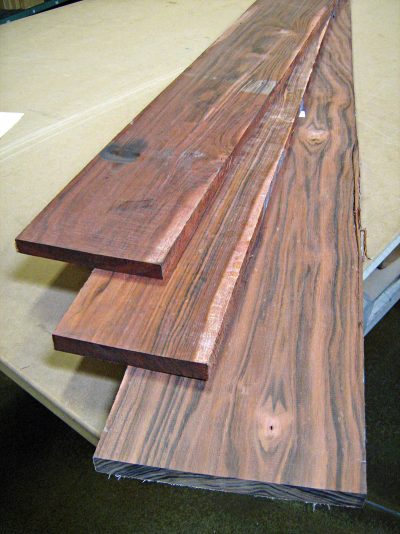 In 1999 Keith, the owner of Woodworkers Source, went to Paraguay to visit a sustainable yield lumber project. He came back with a container load of unusual woods following shortly after.
In 1999 Keith, the owner of Woodworkers Source, went to Paraguay to visit a sustainable yield lumber project. He came back with a container load of unusual woods following shortly after.
When we bring in unusual woods, it’s often with a bit of stand-back-and-wait because even though we’ve seen a sample piece (or maybe not at all), it’s often a surprising what really shows up on the truck.
Curupay (“ker-oo-pay,” more or less), a wood that came from this operation in Paraguay, turned out to be a pleasant surprise and popular wood; due to both the appearance of the raw boards and the machining and finishing characteristics. At first, it was a little odd. The wood had a dark tan color and sporadic, but interesting, dark lines or stripes. As time went by the tan wood changed to red so long as it was exposed to light – and by red I mean an unmistakable brick to burgundy color.
The wood takes a flawless glassy surface with a bit of sanding sealer and a lacquer top coat. The trouble with it was its weight and hardness, which is much like that of bloodwood. Curupay has some interlocking grain that’s difficult to plane and will chip without some special care (such as reduced cutting angle and feed rate). While it doesn’t shine in the department that goes easy on tools and cutters, it does happen to produce excellent results in turning, sanding, polishing, and finishing.
Nevertheless, the wood was a popular one, it sold out, and we hadn’t seen it for a number of years. We had many customers request it, including a project for stairs and interior trim work in a Hawaii bungalow, we just couldn’t locate a source for the wood. That is until about a year ago. One of our long time relationships drummed up a container of a few gorgeous and unusual woods, curupay one of them. As expected the wood looks phenomenal.
In a standard answer, using these lesser known imports spreads out the demand and relieves pressure from the more popular tropical woods. It’s in everyone’s best interest to maintain diversity in the world’s forests. Giving value to various trees means they’d be less likely to be slashed and burned to make space for population growth and ranching.
But more specifically to woodworking, curupay brings a unique look to your projects that you’ll like. It’s also makes a superior choice for outdoor projects as it has a high resistance to decay and impregnation. Curupay will make strong, durable furniture that’s also strikingly beautiful.
Who knows? It might be your next favorite wood.
To help show you the progression of curupay, I’ve taken a small board that’s 8″x24″ and did a little work on it:
It’s hard to believe isn’t it? I didn’t expect the sun to force the dark streaks to fade away, but the finished result is certainly stunning. Don’t you think?
We have seen curupay sold in the flooring industry, to no one’s credit, under the misleading names Patagonia Rosewood and/or Andes Rosewood. Curupay may very well appear “pretty with stripes” it’s not a real rosewood, as defined as being from the Dalbergia genus.
The curupay tree really thrives in northern Argentina (ironically, Patagonia is the southern region of Argentina), and sub-tropical areas of Brazil and Paraguay. The largest it’ll get is about 80 feet tall and just 24 inches in diameter.
For a tropical tree, it’s actually considered small to medium.
Curupay Lumber and Wood
Vice President of Operations – Woodworkers Source
We’re a family-owned lumber & woodworking supply retailer with 3 delightful stores in Arizona, and 35 friendly employees.
Mark oversees the company and creates tutorials on wood finishing and woodworking tips for hardwood lumber.
Woodworkers Source is a division of MacBeath Hardwood Co.
